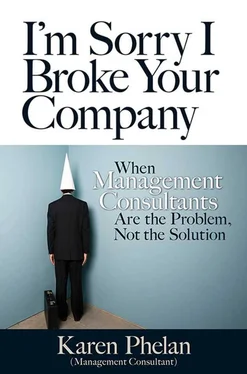Karen Phelan - I'm Sorry I broke Your Company
Здесь есть возможность читать онлайн «Karen Phelan - I'm Sorry I broke Your Company» весь текст электронной книги совершенно бесплатно (целиком полную версию без сокращений). В некоторых случаях можно слушать аудио, скачать через торрент в формате fb2 и присутствует краткое содержание. Город: San Francisco, Год выпуска: 2013, ISBN: 2013, Издательство: Berrett-Koehler Publishers, Жанр: management, popular_business, на английском языке. Описание произведения, (предисловие) а так же отзывы посетителей доступны на портале библиотеки ЛибКат.
- Название:I'm Sorry I broke Your Company
- Автор:
- Издательство:Berrett-Koehler Publishers
- Жанр:
- Год:2013
- Город:San Francisco
- ISBN:978-1-60994-740-8; 978-1-60994-741-5
- Рейтинг книги:3 / 5. Голосов: 1
-
Избранное:Добавить в избранное
- Отзывы:
-
Ваша оценка:
- 60
- 1
- 2
- 3
- 4
- 5
I'm Sorry I broke Your Company: краткое содержание, описание и аннотация
Предлагаем к чтению аннотацию, описание, краткое содержание или предисловие (зависит от того, что написал сам автор книги «I'm Sorry I broke Your Company»). Если вы не нашли необходимую информацию о книге — напишите в комментариях, мы постараемся отыскать её.
I'm Sorry I broke Your Company — читать онлайн бесплатно полную книгу (весь текст) целиком
Ниже представлен текст книги, разбитый по страницам. Система сохранения места последней прочитанной страницы, позволяет с удобством читать онлайн бесплатно книгу «I'm Sorry I broke Your Company», без необходимости каждый раз заново искать на чём Вы остановились. Поставьте закладку, и сможете в любой момент перейти на страницу, на которой закончили чтение.
Интервал:
Закладка:
I found myself at this manufacturer with two accounting consultants who were going to write the requirements for the financial part. They had an office upstairs with the accounting function, while I was a given a space right above the shop floor. Because we weren’t making money on this project and were unlikely to sell any follow-on, the local management basically left us to our own devices. Here I was about twelve months out of college with an engineering degree in electronic materials with absolutely no knowledge of a manufacturing enterprise, trying to solve the company’s problems on my own. Although I was sold as an engineering graduate of MIT (Massachusetts Institute of Technology), my degree was in semiconductors, working at the atomic level with electron microscopes, not exactly the kind of engineering used on a shop floor. (Maybe at a much, much smaller manufacturer!)
I began my analysis with a tour of the shop floor with the supervisor. The first thing I noticed was that there were parts everywhere. Officially called «work in process,» these were unfinished items making their way through the production process. Every machine had two queues of parts — coming in and going out. Because of this, the place was cluttered and filthy. Secondly, every machine operator was busy punching away at a machine. Finally, I noticed several men, better dressed and cleaner than the machine operators, walking around the floor and haggling with the operators. Every time one of these men approached a machine, the operator stopped, and the two appeared to engage in an argument. I asked the shop floor supervisor what these men were doing. He explained that they were expediters. The job of expediters was to take care of rush or high-priority orders by babysitting them all the way through production. An expediter would bring a rush order to the first machine, make sure the first part was produced, bring it to the second machine, and so on until the order was complete. Unfortunately, this process was incredibly disruptive to the production schedule, especially since it had been optimized with expensive software. Each operator had to stop what he was doing, which was making a part for an order, to retool the machine and make the part for the expediter — no wonder the software wasn't working! After the tour, I started talking with shop floor workers and production schedulers and anyone else who would talk to me. Although I was warned that the workers were «union» and likely to be uncooperative, I found that most were more than happy to talk to me, and some even vented all their frustrations with the situation, being grateful for the opportunity to be heard. Their own management was so busy that they never had time to go down to the floor and talk with anyone.
The company's procedure to create a manufacturing schedule was to require It's customers to submit their orders by the end of the month. The orders were then entered into the computer, which spat out an optimized production schedule for the next month. However, the company had several important customers who submitted orders weekly that needed to be filled as soon as possible. At first, these orders were fed into the computer system and a new schedule was created, but because the old schedule was already underway, creating a new schedule with every new order became disruptive. So the new orders were kept separate and handled by expediters. Though in theory the schedule was kept intact, in practice it wasn't being followed by workers, who had to halt what they were doing to accommodate the expediters' requests. As more orders fell behind their commitment dates, more orders were designated «rush» and required expediting, with the result being that the shop floor became less optimized and fewer orders got shipped on time — a vicious circle.
After a few weeks of mostly talking with the employees, I developed a list of their problems with some recommendations. Even though I was told specifically that human resources (HR) was outside the scope of my analysis, the biggest problem was that the workers were compensated by the number of pieces produced and not by meeting the schedule. This meant that if a machine operator had to change the tools on his machine, which took about two hours, to make five pieces, which took about thirty minutes, he would make more than five parts to compensate for the changeover time. The extras would sit at the workstation and, with any luck, be found when that part was needed again. Making the situation worse, the machine operators would always appease the expediters first before following the schedule because the expediters were breathing down their necks. Again, the operators would make more than one part if they had to change tools. Finally, they would look at the schedule and see how much of that they could accomplish before the end of the day.
All the workers knew that this approach was contrary to meeting their order commitments, but this was how the floor operated. They had incentive compensation based on the number of pieces produced, so they were going to produce as many as they could, even if those pieces weren't needed. Worse, making these unnecessary pieces consumed the raw materials that were ordered for required pieces, so the operators were always running out of raw materials. This meant that the purchasing department had to order more than the schedule required, which only allowed the operators to make even more unnecessary parts. The net result was a complete disaster — lots of unsellable inventory, few completed orders, and a scarcity of raw materials.
Obviously, my first recommendation was to stop compensating employees based on the number of pieces produced and to move to on-time order fulfillment as a collective goal. I also recommended that the company get rid of the expediters and move to a weekly production schedule because customers were sending in their orders on a weekly basis anyway. It doesn't matter how nice the optimized monthly schedule looks on paper. If your customers are sending in orders every week and you are incorporating those orders into your schedule, then you are actually working from a weekly schedule. The monthly paper schedule is just pretend. I also made some recommendations for changing the order lead times and creating a separate job shop. I wish I could say that the company implemented these changes, improved It's ability to ship orders, lowered It's inventory and production costs, and became immensely profitable. However, after I wrote the report and presented it to management, I went on to another assignment. The president and his team seemed pleased with the recommendations, but a year later the company was bought by a larger appliance maker without having implemented much of anything.
Although at first I was a little resentful of having to work on my own at my first client, it forced me to rely on the employees for all my information and on myself to think things through. Normally, I wouldn't have had the chance to talk with so many people or spend lots of time «just thinking.» In consulting, where you are rated on your ability to hit the ground running, thinking is often considered a non-value-adding activity. What I deliberated on was that, contrary to the advice that the union employees would be unhelpful and even dishonest, I found that most of them knew exactly what the problems were and wanted to help, but not only were they powerless to change the way things worked, they were alienated. The relationship between the employees on the shop floor and the management team was hostile. All it took was one painful labor contract negotiation, and the mutual mistrust soured the relationship permanently. The whole time I was there, I never saw anyone from management on the shop floor, and the workers certainly never volunteered information to their supervisors. Each painted the other as evil, greedy, uncaring, and stupid, and each used the one or two exceptions of purely self-interested people on the other side to define everyone else. Some of the human resources policies were meant to deal with these exceptions, but unfortunately, they applied to everyone else as well. What I found frustrating was that people rarely spoke to others outside their areas, and I often found myself acting as a communications vehicle. Another thing I found very frustrating was «scope creep.» My manager had warned me to stick to the manufacturing operations and avoid the common consulting pitfall of scope creep, but many of the problems had their causes outside the manufacturing area. The incentive system was the root of many of the evils, but the lack of information sharing and poor relationships with customers and suppliers also created shop floor problems. I discovered that some purchasing departments would create duplicate orders at different facilities to get product faster and then cancel what they didn't need. To really fix the shop floor, you would have to include everyone else in the supply chain.
Читать дальшеИнтервал:
Закладка:
Похожие книги на «I'm Sorry I broke Your Company»
Представляем Вашему вниманию похожие книги на «I'm Sorry I broke Your Company» списком для выбора. Мы отобрали схожую по названию и смыслу литературу в надежде предоставить читателям больше вариантов отыскать новые, интересные, ещё непрочитанные произведения.
Обсуждение, отзывы о книге «I'm Sorry I broke Your Company» и просто собственные мнения читателей. Оставьте ваши комментарии, напишите, что Вы думаете о произведении, его смысле или главных героях. Укажите что конкретно понравилось, а что нет, и почему Вы так считаете.












